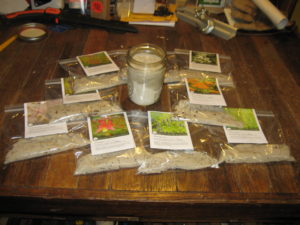How to Stratify Prairie Seed
In mid-February, as I was prepping some purchased prairie seed for stratification, it occurred to me that this might be an unfamiliar process and worth sharing.
For prairie seed, most of which is small and depends on wind or the passage of large mammals to disperse it, the purpose of stratification is to simulate the effects of winter. So if you plant it in late autumn or early winter, there is no need for this ritual because it will experience the real thing, perhaps including getting eaten by birds or rodents. But if your seed catalog order doesn’t arrive until mid-winter or you want to wait until spring to plant, then stratification is worthwhile in order to get reliable germination.
The game plan is to keep the seed cool and slightly moist for at least a month of two over winter, without letting it get moldy. Moldy seed is dead seed, hence only slightly moist. For small amounts of purchased seed, my preferred method is to put 3 or 4 heaping teaspoons of slightly damp silica sand in a plastic zipper-type of sandwich bag, work in the seed, zip the bag, staple the label above the seal, and store in the fridge or fruit cellar in a conspicuous place where I will remember to inspect often.

Jar of wet and dry silica sand before mixing, surrounded by prepared plastic bags of seed in sand.
Any sand will work, but silica sand is very fine and pure white, resembling granulated sugar. It is easy to judge how wet you are making it by putting it in a clear glass or plastic container and slowly adding cold water, which will darken the color. Wetting the top quarter is adequate, then mix the wet and dry and you will have slightly damp sand.
Come planting time in the field, you are actually planting sand with a bit of seed attached, and the white sand contrasts nicely with the black or brown dirt so you can see where you have planted the tiny dark seeds, some of which are nearly microscopic dust. A few extreme examples of small size are harebell with 900,000 seeds per ounce, slender false foxglove with 800,000, Indian paintbrush with 300,000 and grassleaved goldenrod with 350,000. There are dozens of prairie species with more than 10,000 seeds per ounce.
An ideal temperature for stratification is just a bit above freezing, which is maintained in your fridge when set on the low side. Some attached garages or breezeways also hold that approximate temperature during winter. Here mice are a concern, but 1/4” mesh hardware cloth can be shaped into a lid for a stout box or bucket to keep them out.
Different prairie species have different requirements for the minimum chill time needed to reset their chemical clocks – so when they warm up again they know that spring has arrived. For most upper Midwestern species, two months chill is adequate, and for many, one month will suffice.
Because each seed is a product of cross pollination, each has its own genetic inheritance. So within each little batch, there will be a few who decide to start growing while in cold storage. If it is only a few, just remove them and continue on. But if a lot of them all sprout together during stratification, perhaps the seeds are southern (where stratification is not so necessary), or they are mislabeled, or temperatures are too high or too variable for them to chill out. These can sometimes be salvaged by planting immediately in soil indoors in a sunny spot and holding them until after frost. But this is an uncommon problem.
For purchasing prairie, wetland and savanna seed I particularly favor Prairie Moon Nursery. This is a second generation prairie seed business and their “catalog and cultural guide” is very complete with details about stratification requirements of each species. It also harbors quite specific information about their pollinators.
The seeds of our native shrubs also require stratification, but they have a different strategy, ruled by birds, and we will address them next week. Perhaps this seems a bit complicated, but once you’ve done it, future stratifications are no big deal.
Tags: Lon Drake, prairie restoration, prairie seed, seed stratification

